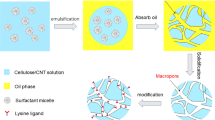Abstract
The aim of this work was to synthesize and characterize cellulose microspheres with a particle size below 5 μm and narrow size distribution. After activation and functionalization with antibodies, these particles shall be applied as adsorbents in suspension-based extracorporeal blood purification systems, such as the Microspheres-Based Detoxification System. In the frame of this work such microspheres were developed and synthesized with reproducible properties. Besides using well-established methods for characterization of this kind of bead cellulose, additional procedures for the examination of its properties were developed and applied.









Similar content being viewed by others
References
Ash SR, Sullivan TA, Carr DJ (2006) Sorbent suspensions versus sorbent columns for extracorporeal detoxification in hepatic failure. Ther Apher Dial 10:145–153
Bohren CF, Huffman DR (1998) Absorption and scattering of light by small particles. Wiley, New York
de Oliveira W, Glasser WG (1996a) Hydrogels from polysaccharides. I. Cellulose beads for chromatographic support. J Appl Polym Sci 60:63–73
de Oliveira W, Glasser WG (1996b) Hydrogels from polysaccharides. II. Beads with cellulose derivatives. J Appl Polym Sci 61:81–86
Falkenhagen D, Brandl M, Hartmann J, Kellner KH, Posnicek T, Weber V (2006) Fluidized bed adsorbent systems for extracorporeal liver support. Ther Apher Dial 10:154–159
Feldner A (2009) Entwicklung von Methoden zur Charakterisierung von Perlcellulosen. Master’s thesis, TU Dresden (Institute of plant and wood chemistry)
Fischer S, Thümmler K, Volkert B, Hettrich K, Schmidt I, Fischer K (2008) Properties and applications of cellulose acetate. Macromol Symp 262:89–96
Fraunhofer J (1817) Bestimmung des Brechungs- und Farbzerstreuungsvermögens verschiedener Glasarten. Gilberts Ann Phys 56:193–226
Heinze Th, Liebert T (2004) Chemical characteristics of cellulose acetate. Macromol Symp 208:167–237
Jones RM (2003) Particle size analysis by laser diffraction: ISO 13320, standard operating procedures and Mie theory. Am Lab 35:44–47
Kaster JA, de Oliveira W, Glasser WG, Velander WH (1993) Optimization of pressure-flow limits, strength, intraparticle transport and dynamic capacity by hydrogel solids content and bead size in cellulose immunosorbents. J Chromatogr A 648:79–90
Kuga S (1980) New cellulose gel for chromatography. J Chromatogr 195:221–230
Mie G (1908) Beiträge zur Optik trüber Medien, speziell kolloidaler Metalllösungen. Ann Phys 330:377–445
Naining W, Hongjian Z (1986) A study of the accuracy of optical Fraunhofer diffraction size analyser. Part Sci Technol 4:403–408
O`Neill JJ, Reichardt EP (1951) Cellulose pellets. US 2543928
Peška J, Štamberg J, Hradil J, Ilavský M (1976) Cellulose in bead form: properties related to chromatographic uses. J Chromatogr 125:455–469
Sobisch T, Lerche D, Fischer S, Fanter C (2006) Characterization of porous bead celluloses by analytical centrifugation. Prog Colloid Polym Sci 133:169–172
Volkert B, Wolf B, Fischer S, Li N, Lou C (2009) Applications of modified bead cellulose as a carrier of active ingredients. Macromol Symp 280:130–135
Wagenknecht W, Fanter C, Loth F (1996) Process for producing spherical microparticles on the basis of cellulose acetate. EP 0750007
Weber V, Hartmann J, Linsberger I, Falkenhagen D (2007) Efficient adsorption of tumor necrosis factor with an in vitro set-up of the Microspheres-Based Detoxification System. Blood Purif 25:169–174
Weber V, Ettenauer M, Linsberger I, Loth F, Thümmler K, Feldner A, Fischer S, Falkenhagen D (2010) Functionalization and application of cellulose microparticles as adsorbents for extracorporeal blood purification. Macromol Symp 294:90–95
Wolf B, Horsch W (1991) Herstellung, Eigenschaften und Verwendung der Perlcellulose—eine Übersicht. Pharmazie 46:392–402
Wolf B, Schmitz W, Schneider H (1996) Composites of bead cellulose and hydrophilic solubiliziers. Int J Pharm 139:87–94
Acknowledgments
The authors are indebted to Dr. Emanuele Martorana (Munich University of Applied Sciences), Dr. Jens Schaller (TITK Rudolstadt), Dr. Carola Fanter (IAP Potsdam) and Mr. Ernst Bäucker (Institute of Forest Utilization, TU Dresden) for their skillful support during performing the measurements.
Author information
Authors and Affiliations
Corresponding author
Rights and permissions
About this article
Cite this article
Thümmler, K., Fischer, S., Feldner, A. et al. Preparation and characterization of cellulose microspheres. Cellulose 18, 135–142 (2011). https://doi.org/10.1007/s10570-010-9465-z
Received:
Accepted:
Published:
Issue Date:
DOI: https://doi.org/10.1007/s10570-010-9465-z




